Last updated on April 14th, 2024
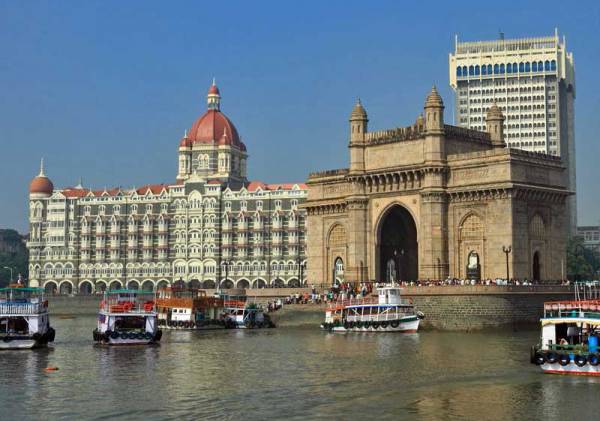
Taj Mahal Hotel & Gateway of India, © Can Stock / mkistryn
Visit Mumbai – Gateway of India
The Gateway of India is the most popular attraction for those who visit Mumbai. The Gateway of India commemorates the visit of King George V. It’s located on the Colaba waterfront in the heart of the city, directly beside the famous Taj Mahal Palace and Tower Hotel. When Britain granted India independence in 1947, British soldiers departed through this gate. Just behind the hotel is Leopold Cafe and Bar, which was the site of the 2008 terrorist bombings.
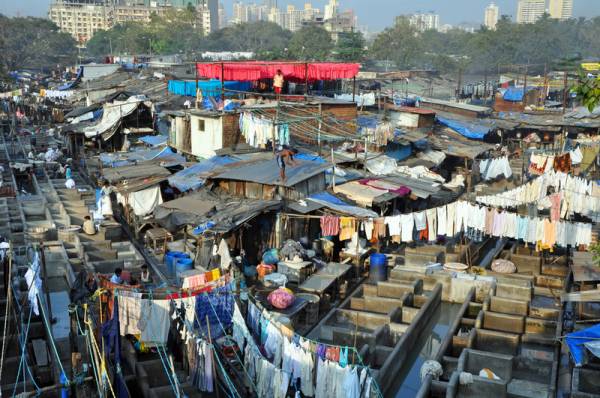
Dhobi Ghat Outdoor Laundry, © Can Stock / johnnydevil
Visit Mumbai – Dhobi Ghat Outdoor Laundry
On the peninsula just south of the Gateway of India is an area of contrasts. The skyscrapers along the waterfront in the area known as Cuffe Parade are very close to the Mahalaxmi Dhobi Ghat outdoor laundry, where hundreds of families wash laundry. At the Dhobit Ghat outdoor laundry, the laundry is done by hand for a few dollars a day in rows of concrete troughs. Tourist come to take pictures of poverty that they can barely comprehend. The Mumbai Port Trust Botanical Garden is nearby on the peninsula here too.
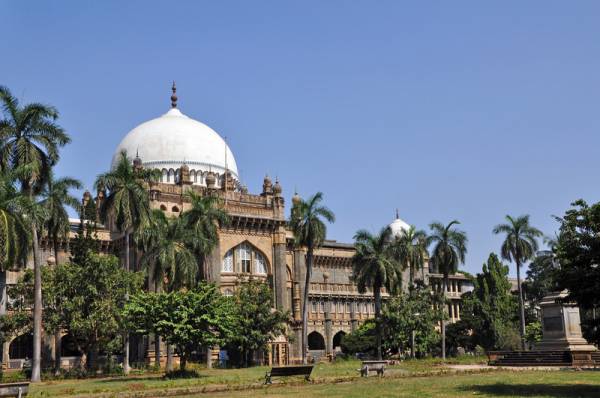
Museum Mumbai, © Can Stock / johnnydevil
Kala Ghoda (Black Horse) Art Precinct
The Kala Ghoda (Black Horse) Art Precinct is immediately to the north of the Gateway of India. Among the galleries in the Kala Ghoda are the Jehangir Art Gallery and the Museum Mumbai (CSMVS), which was formerly called the Prince of Wales Museum. The multi-day Kala Ghoda Festival is held here in early February.
Visit Mumbai – Colaba
The larger area north of the Gateway of India is still part of the peninsula known as Colaba, the Fort or Colaba Fort. A military installation was here previously, which gives rise to the name. In the northern section of Colaba, see the Rajabai Clock Tower, which is Mumbai’s version of Big Ben. Watch a trial at the Bombay High Court. Check out the Flora Fountain in Martyr’s Square and St Thomas Cathedral at Horniman Circle.
On the fringes of this area you will find the cruise ship terminal to the east and a bit farther north is the Chhatrapati Shivaji Terminus (formerly Victoria Terminus), which is an historic train station recognized as a World Heritage Site.
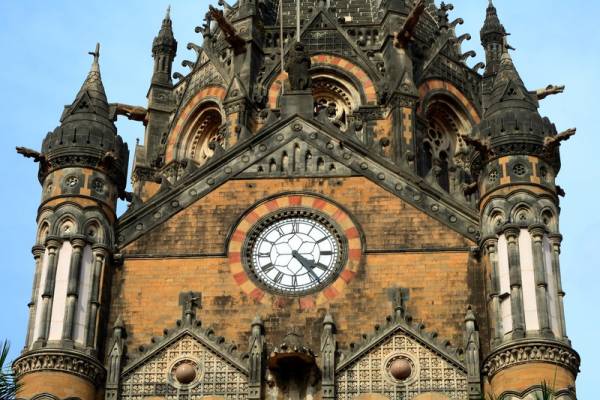
Chhatrapati Shivaji Terminus, © Can Stock / SHAILESHNANAL
Marine Drive – The Queen’s Necklace
Marine Drive is a popular road and waterfront promenade on Back Bay in the heart of downtown Mumbai. Back Bay extends in a sweeping semi-circle which starts at Nariman Point in the downtown area. Chowpatty Beach is just past the halfway point around the semi-circular drive. Inland from Chowpatty Beach is the Khotachiwadi area with its Portuguese architecture. Marine Drive is known for its art Deco buildings and for being a great place to watch the sunset. At night, the arc of the beach and the city lights create the Queen’s Necklace.
Visit Mumbai – Banganga Tank
At the farthest end of Marine Drive, you will find the Banganga Tank Water Reservoir and the impressive Jain Temple. The Banganga Tank is a large rectangular sacred pool built in the early 1100s. It’s part of the Walkershwar Temple complex at Malabar Hill. Observe the ancient Indian tradition of entering the holy waters of Banganga Tank or catch a festival held at the location.
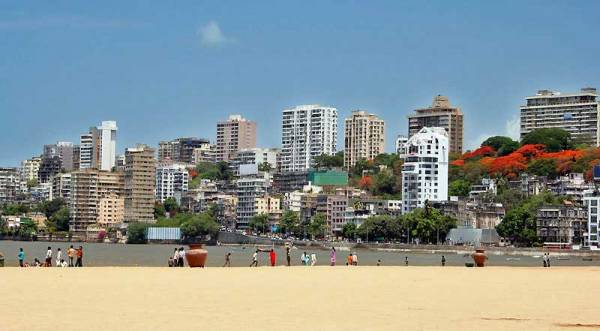
Chowpatty Beach, © Can Stock / Sapsiwai
Churchgate Station Lunch Boxes
A few blocks in from the waterfront Marine Drive, visit Churchgate Station. Watch the Churchgate Station lunch boxes being unloaded at the railway station just before noon and handed to Mumbai Dabbawalas. The dabbawalas deliver several hundred thousand hot lunch boxes around the city each day. The British aristocracy started the lunch box tradition, but it has been taken over by the businessmen of Mumbai.
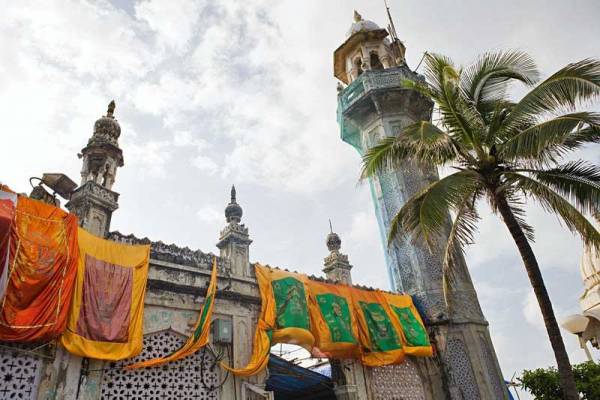
Haji Ali Dargah Mosque, © Can Stock / micropix
Visit Mumbai – Haji Ali Dargah
Haji Ali Dargah Mosque and Tomb have been around since 1431. The Haji Ali Dargah has a white dome and white minarets. This mosque is on a small island just off the coast, north of downtown. A causeway helps people get to the site without worrying about the tides. During heavy monsoons, access to the mosque can be cut off.
The Haji Ali Dargah Mosque is enormously popular. It’s very busy with pilgrimages on Thursdays and Fridays. Tours will drive through the wealthy Breach Candy residential area to reach the mosque.
Visit Mumbai – Hotels
- Trident Nariman Point
- Taj Mahal Palace and Tower Hotel
- Hotel Sahara Star-Mumbai Airport
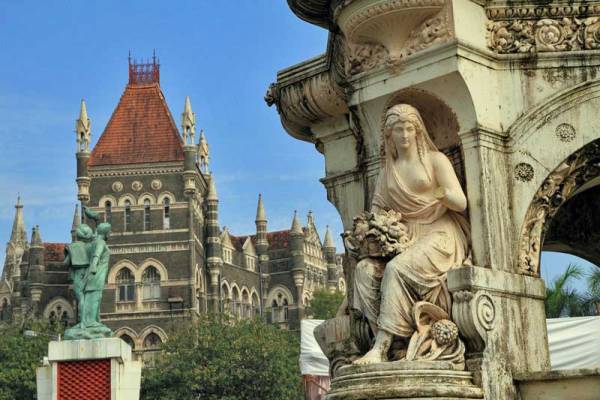
Flora Fountain, © Can Stock / mkistryn
Visit Mumbai – Gandhi Museum
You will find the Mani Bhavan Gandhi Museum about half way between downtown and the airport. This was Gandhi’s home for 17 years. The Gandhi Museum is right beside the Dharavi Slum, which is the largest slum in Asia.
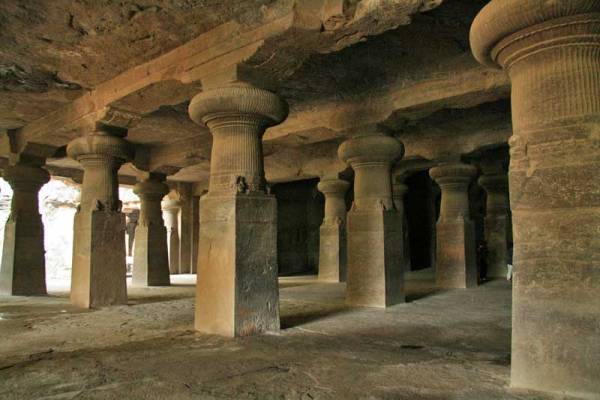
Elephanta Island, © Can Stock / imagex
Visit Mumbai – Elephanta Caves
UNESCO has designated the Elephanta Caves as a World Heritage Site. You can reach the Elephanta Caves by ferry from downtown Mumbai. The Elephanta Caves are dedicated to the Hindu Lord Shiva. Enjoy great views of Mumbai on the ferry ride too.
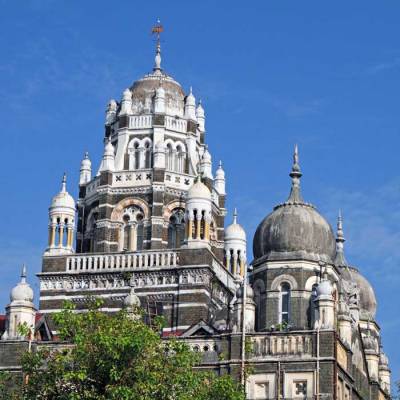
Churchgate Station, © Can Stock / mkistryn
Visit Mumbai – More Sights
North of the main tourist area of Mumbai, a few minutes by vehicle, you will find the Chor Bazaar Thieves Market and Crawford Market. For even more exiting market excursions, book a guided tour to the bazaars of Kalbadevi and Bhuleshwar.
Jijamata Udyan was formerly called the Victoria Gardens and is the site of gardens, the Mumbai Zoo and the Bhau Daji Laud Museum.
Take the trip by vehicle across the Bandra-Worli Sea Link. This 8 lane bridge is more than 3 miles long and crosses Mahim Bay. Mount Mary Bascilica is located near the northern end of the bridge in Bandra. The church and the bridge are both extremely popular sites.
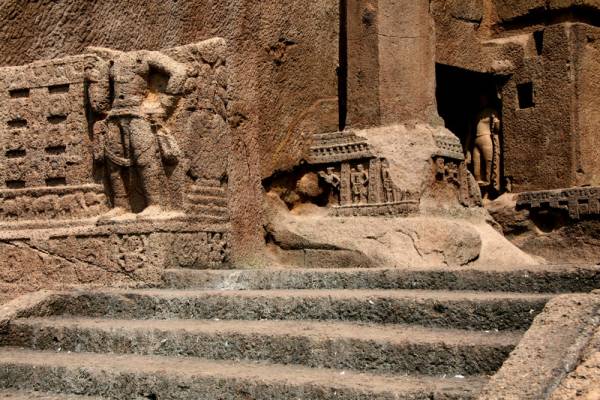
Kanheri Caves, © Can Stock / imagex
Things to See and Do near Mumbai
- Sanjay Gandhi National Park – An extremely large urban park. This is the location of the Kanheri Caves, which have Buddhist carvings in the volcanic rock.
- Juhu Beach – about 20 minutes north of the city center.
- Global Vispassana Pagoda – this Buddhist temple is one of the highlights of Mumbai.
- Esselworld Water Kingdom – adventure parks north of town.
Savor the Tastes of Mumbai
Chaat refers to roadside carts serving snack meals. There are so many options that you will almost need a tour guide or a local to help you decide what to eat. Dishes might include:
- Golgappa or Panipuri – unleavened bread filled with tamarind, chili, masala, potato, onion and chickpeas.
- Pav bhaji – vegetable curry & bread.
- Ragda patties – dried yellow pea soup and potatoes.
- Egg parathas, liver curry, pakoras and samosas.
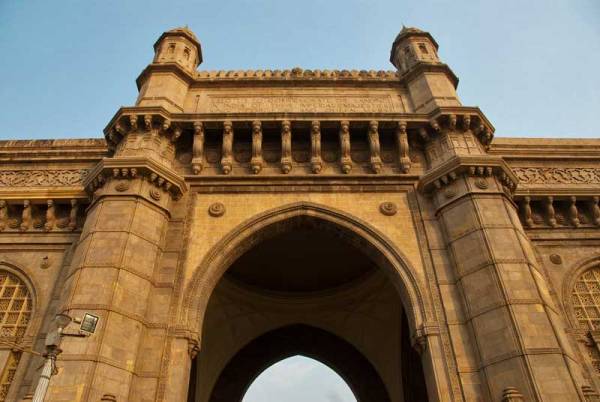
Gateway of India, © Can Stock / yellowcrest
Get Around Mumbai
Cab is the best way to get around Mumbai. A cab ride from Chhatrapati Shivaji International Airport Mumbai (BOM) to the downtown area at the Gateway of India takes about an hour. You can purchase prepaid cab rides at the airport. Cabs are plentiful throughout the city and are reasonably priced. Mumbai has train connections with many cities in India from multiple stations, such as the well known Chhatrapati Shivaji Terminus (Victoria Terminus or VT).
Cruise Ships
Cruise ships dock at Ballard Pier, which is a short distance past the Gateway of India. The Gateway of India and the adjacent Taj Mahal Hotel are the first sights cruise ship passengers see as they enter the port.
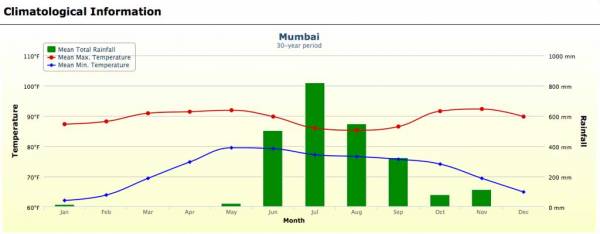
Weather Graph for Mumbai
Mumbai Weather
The main factor for Mumbai weather is the monsoon season from June to September. Monsoon season peaks in July with average rainfall of more than 30 inches (850 mm) that month. Severe flooding in the river delta of the city has increased in recent years.
Temperatures in Mumbai do not vary greatly and average highs are around 90 F (32 C) throughout the year. Average lows can dip into the 60s F (16 C) in the winter months.
Visit Mumbai – Festivals
February might be the best time of year to visit Mumbai for good weather. Festivals like the Hindu Ganesh Festival in September, 9 nights of the Hindu Navaratri in October or the Kala Ghoda Festival in February might be a bigger factor in deciding when to visit Mumbai.
Mumbai Terrorist Attacks
Since the 1990s, Mumbai has been subjected to several terrorist bombings. A commuter train bombing in 2006 killed and injured many people. Bombings have also occurred in 2008 and 2011.
Visit Mumbai – Background
Mumbai was known as Bombay when the British East India Company controlled India. It was renamed back to Mumbai in 1996. Mumbai is the largest city in India. More than 20 million people live there. The city has an excellent harbor on the Arabian Sea. Mumbai is one of the wealthier cities in India, but it also has Asia’s largest slum. Land reclamation has caused the original 7 islands of Mumbai to blend together into one gigantic landscape.
A number of dynasties controlled the Mumbai area through the centuries. The Mughal Empire dominated the city in the early 1500s, but ceded to the Portuguese in 1534. In the 1600s the British East India Company took over.

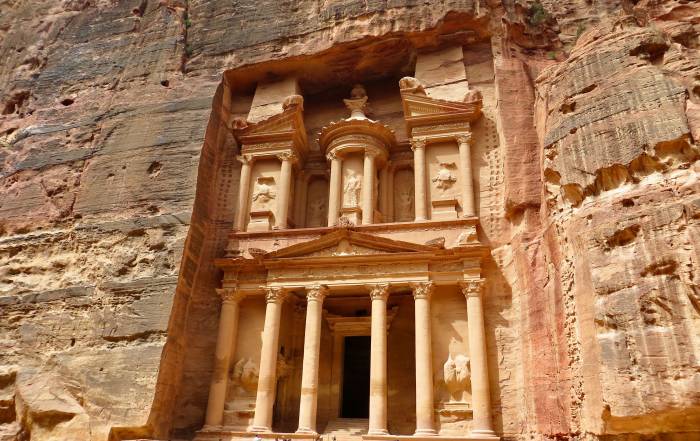
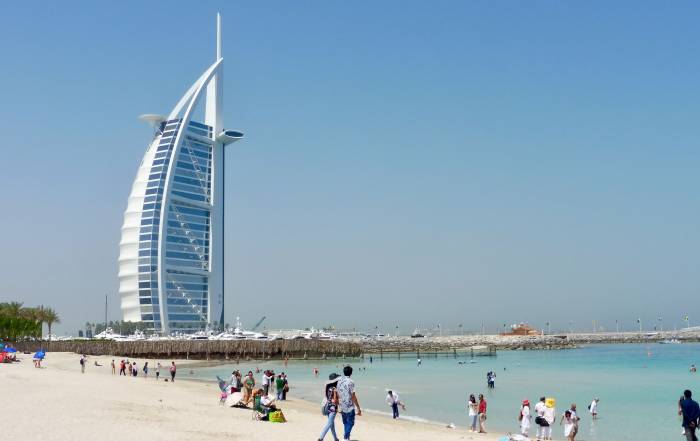
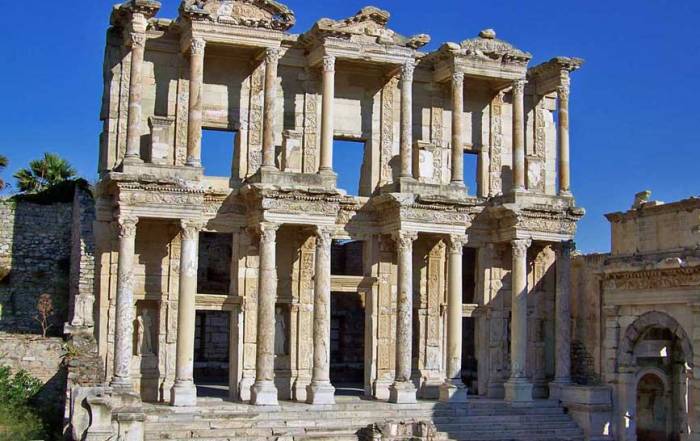
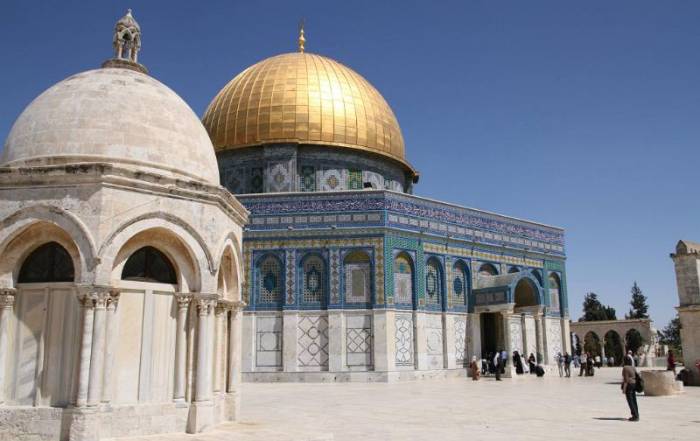
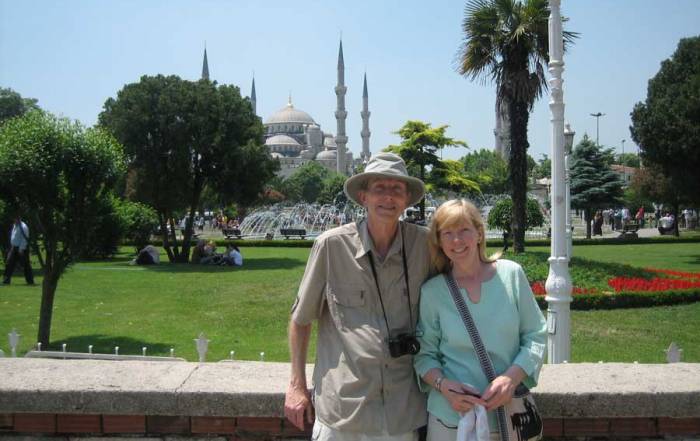
Leave A Comment